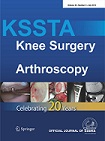
ARTHROPLASTY
Patient-specific vs conventional instrumentation for component rotational alignment in TKA
This report has been verified
by one or more authors of the
original publication.
Knee Surg Sports Traumatol Arthrosc. 2014 Mar;22(3):636-42. doi: 10.1007/s00167-013-2639-0. Epub 2013 Aug 29.
45 patients scheduled to undergo total knee arthroplasty (TKA) were randomized to receive either patient-specific or conventional instrumentation. The purpose of this study was to compare these two techniques with respect to the rotational alignment of both the femoral and tibial components, as assessed by computed tomography (CT). Results at 1 week post-operation indicated that, although there was no significant difference between groups with respect to both femoral and tibial component rotation, the dispersion of tibial rotation from a neutral position, both internally and externally, was greater in the conventional instrumentation group.
Unlock the full ACE Report
You have access to {0} free articles per month.Click below to unlock and view this {1}
Unlock NowCritical appraisals of the latest, high-impact randomized controlled trials and systematic reviews in orthopaedics
Access to OrthoEvidence podcast content, including collaborations with the Journal of Bone and Joint Surgery, interviews with internationally recognized surgeons, and roundtable discussions on orthopaedic news and topics
Subscription to The Pulse, a twice-weekly evidence-based newsletter designed to help you make better clinical decisions
Exclusive access to original content articles, including in-house systematic reviews, and articles on health research methods and hot orthopaedic topics
Or upgrade today and gain access to all OrthoEvidence content for just $1.99 per week.
Already have an account? Log in


Subscribe to "The Pulse"
Evidence-Based Orthopaedics direct to your inbox.
{0} of {1} free articles
Become an OrthoEvidence Premium Member. Expand your perspective with high-quality evidence.
Upgrade Now













































































